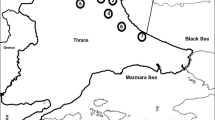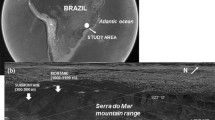Abstract
Carbon isotope ratios (δ13C) were studied in evergreen and deciduous forest ecosystems in semi-arid Utah (Pinus contorta, Populus tremuloides, Acer negundo and Acer grandidentatum). Measurements were taken in four to five stands of each forest ecosystem differing in overstory leaf area index (LAI) during two consecutive growing seasons. The δ13Cleaf (and carbon isotope discrimination) of understory vegetation in the evergreen stands (LAI 1.5–2.2) did not differ among canopies with increasing LAI, whereas understory in the deciduous stands (LAI 1.5–4.5) exhibited strongly decreasing δ13Cleaf values (increasing carbon isotope discrimination) with increasing LAI. The δ13C values of needles and leaves at the top of the canopy were relatively constant over the entire LAI range, indicating no change in intrinsic water-use efficiency with overstory LAI. In all canopies, δ13Cleaf decreased with decreasing height above the forest floor, primarily due to physiological changes affecting c i/c a (> 60%) and to a minor extent due to δ13C of canopy air (< 40%). This intra-canopy depletion of δ13Cleaf was lowest in the open stand (1‰) and greatest in the denser stands (4.5‰). Although overstory δ13Cleaf did not change with canopy LAI, δ13C of soil organic carbon increased with increasing LAI in Pinus contorta and Populus tremuloides ecosystems. In addition, δ13C of decomposing organic carbon became increasingly enriched over time (by 1.7–2.9‰) for all deciduous and evergreen dry temperate forests. The δ13Ccanopy of CO2 in canopy air varied temporally and spatially in all forest stands. Vertical canopy gradients of δ13Ccanopy, and [CO2]canopy were larger in the deciduous Populus tremuloides than in the evergreen Pinu contorta stands of similar LAI. In a very wet and cool year, ecosystem discrimination (Δe) was similar for both deciduous Populus tremulodies (18.0 ± 0.7‰) and evergreen Pinus contorta (18.3 ± 0.9‰) stands. Gradients of δ13Ccanopy and [CO2]canopy were larger in denser Acer spp. stands than those in the open stand. However, 13C enrichment above and photosynthetic draw-down of [CO2]canopy below tropospheric baseline values were larger in the open than in the dense stands, due to the presence of a vigorous understory vegetation. Seasonal patterns of the relationship δ13Ccanopy versus 1/[CO2]canopy were strongly influenced by precipitation and air temperature during the growing season. Estimates of Δe for Acer spp. did not show a significant effect of stand structure, and averaged 16.8 ± 0.5‰ in 1933 and 17.4 ± 0.7‰ in 1994. However, Δe varied seasonally with small fluctuations for the open stand (2‰), but more pronounced changes for the dense stand (5‰).
Similar content being viewed by others
Author information
Authors and Affiliations
Additional information
Received: 15 April 1996 / Accepted: 19 October 1996
Rights and permissions
About this article
Cite this article
Buchmann, N., Kao, WY. & Ehleringer, J. Influence of stand structure on carbon-13 of vegetation, soils, and canopy air within deciduous and evergreen forests in Utah, United States. Oecologia 110, 109–119 (1997). https://doi.org/10.1007/s004420050139
Issue Date:
DOI: https://doi.org/10.1007/s004420050139




